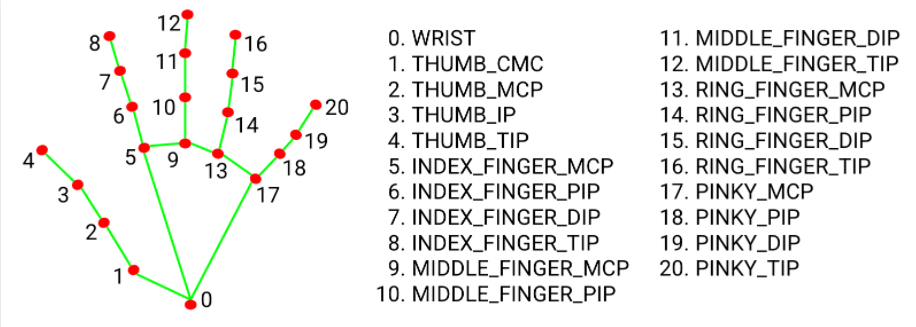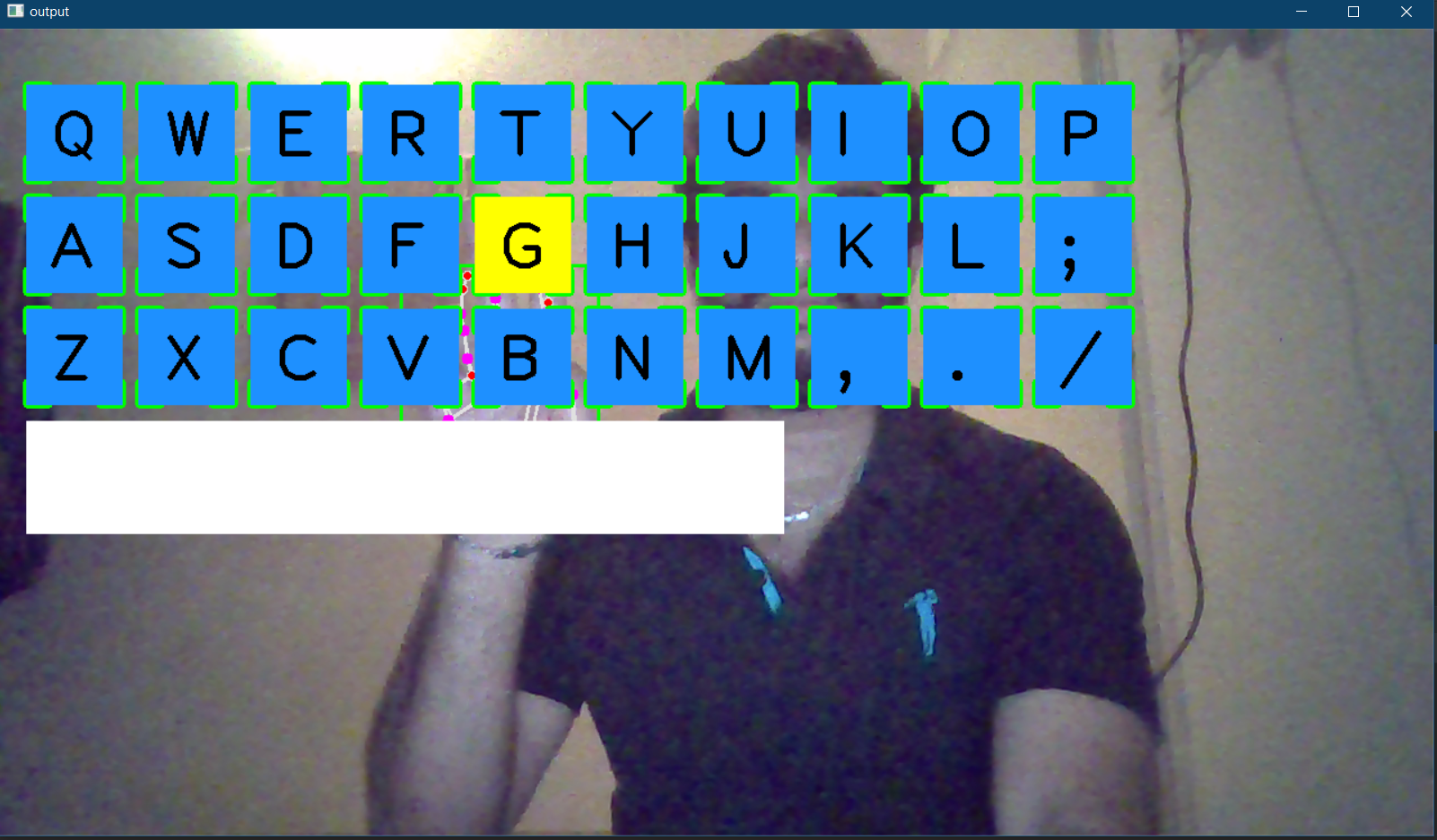How to Develop a Virtual Keyboard Using OpenCV
This article was published as a part of the Data Science Blogathon
Introduction
OpenCV is the most popular library for the task of computer vision, it is a cross-platform open-source library for machine learning, image processing, etc. using which real-time computer vision applications are developed.
CVzone is a computer vision package, where it uses OpenCV and MediaPipe libraries as its core that makes us easy to run like hand tracking, face detection, facial landmark detection, pose estimation, etc., and also image processing and other computer vision-related applications. Check here for more information.
Implementation of Virtual Keyboard Using OpenCV
Let us create a virtual Keyboard.
First, let us install the required modules.
---> pip install numpy ---> pip install opencv-python ---> pip install cvzone ---> pip install pynput
Import Libraries for Virtual Keyboard Using OpenCV
Now let’s import the required modules
import cv2 import cvzone from cvzone.HandTrackingModule import HandDetector from time import sleep import numpy as np from pynput.keyboard import Controller
Here we are importing the HandDetector module from cvzone.HandTrackingModule and then in order to make the virtual keyboard work we need to import Controller from pynput.keyboard.
cap = cv2.VideoCapture(0, cv2.CAP_DSHOW) cap.set(3, 1280) cap.set(4, 720)
Now let’s take real-time input from cv2.Videocapture
detector = HandDetector(detectionCon=0.8)
keyboard_keys = [["Q", "W", "E", "R", "T", "Y", "U", "I", "O", "P"],
["A", "S", "D", "F", "G", "H", "J", "K", "L", ";"],
["Z", "X", "C", "V", "B", "N", "M", ",", ".", "/"]]
final_text = ""
We initialize HandDetector with detection confidence of 0.8 and assign it to the detector. Then we create an array of lists according to the layout of our keyboard and define an empty string to store the typed keys.
Defining Draw Function
keyboard = Controller()
def draw(img, buttonList):
for button in buttonList:
x, y = button.pos
w, h = button.size
cvzone.cornerRect(img, (button.pos[0], button.pos[1],
button.size[0],button.size[0]), 20 ,rt=0)
cv2.rectangle(img, button.pos, (int(x + w), int(y + h)), (255, 144, 30), cv2.FILLED)
cv2.putText(img, button.text, (x + 20, y + 65),
cv2.FONT_HERSHEY_PLAIN, 4, (0, 0, 0), 4)
return img
Initialize the keyboard controller, and define a function with name draw() and it takes two arguments that is an image and the buttonList and return the image. Here Inside the draw() function, we are using cvzone’s cornerRect function to draw rectangle edges at the corner of each keys. It is in order to make our keyboard layout look better. It will look something like the below images.

You can also try changing different colours.
class Button():
def __init__(self, pos, text, size=[85, 85]):
self.pos = pos
self.size = size
self.text = text
Then we define a class called Button() and we give position, text and size as the inputs so that we can arrange the keyboard keys in a well-defined order.
buttonList = []
# mybutton = Button([100, 100], "Q")
for k in range(len(keyboard_keys)):
for x, key in enumerate(keyboard_keys[k]):
buttonList.append(Button([100 * x + 25, 100 * k + 50], key))
The above loop will loop through the keyboard keys and Button objects where we give position and text as inputs are appended in a list called button list. Later we can pass this list to draw function to draw on top of our real-time frame.
Main Program for Virtual Keyboard Using OpenCV
Here comes the important part.
while True:
success, img = cap.read()
img = detector.findHands(img)
lmList, bboxInfo = detector.findPosition(img)
img = draw(img, buttonList) # change the draw funtion to transparent_layout for transparent keys
if lmList:
for button in buttonList:
x, y = button.pos
w, h = button.size
if x < lmList[8][0]<x+w and y < lmList[8][1] < y+h:
cv2.rectangle(img, button.pos, (x + w, y + h),
(0, 255, 255), cv2.FILLED)
cv2.putText(img, button.text, (x + 20, y + 65),
cv2.FONT_HERSHEY_PLAIN, 4, (0, 0, 0), 4)
l, _, _ = detector.findDistance(8,12, img, draw=False)
print(l)
if l < 25:
keyboard.press(button.text)
cv2.rectangle(img, button.pos, (x + w, y + h),
(0, 255, 0), cv2.FILLED)
cv2.putText(img, button.text, (x + 20, y + 65),
cv2.FONT_HERSHEY_PLAIN, 4, (0, 0, 0), 4)
final_text += button.text
sleep(0.20)
cv2.rectangle(img, (25,350), (700, 450),
(255, 255, 255), cv2.FILLED)
cv2.putText(img, final_text, (60, 425),
cv2.FONT_HERSHEY_PLAIN, 4, (0, 0, 0), 4)
# cv2.rectangle(img, (100,100), (200,200),
# (100, 255, 0), cv2.FILLED)
# cv2.putText(img, 'Q', (120,180), cv2.FONT_HERSHEY_PLAIN, 5,
# (0, 0, 0), 5)
# img = mybutton.draw(img)
cv2.imshow("output", img)
cv2.waitKey(1)
Inside the while loop the main function takes place, first we read the real-time input frames and store it in a variable called img. Then we pass that image to the detector.findHands() in order to find the hand in the frame. Then in that image, we need to find the position and bounding box information of that detected hand.
Here we can find the distance between the top point of our index finger and middle finger, if the distance between the two is less than a certain threshold, then we can type the letter on which we are indicating. Once we get the position then we loop through the entire position list. From that list, we find button position and button size and then we plot it on the frame according to a well-defined manner.

After that, we need to find the distance between the top point of our index finger and middle finger. In the above image, you can see the top points which we require are point 8 and point 12. Hence we need to pass 8, 12 inside a distance finding function in order to get the distance between them. In the above code you can see detector.findDistance() and there we passed 8, 12, and image in order to find the distance and we set the draw flag to false so that we do not need any line between the two points.
If the distance between the points is very less we will use press() function to press the keys. In the above code keyboard.press() and we are passing button.text in order to display that pressed key. And finally, we draw a small white rectangular box just below our keyboard layout in order to display the pressed key.
Once you execute the whole code it looks something like this.

After you bring the index finger and middle finger close to each other on top of a particular letter, you can type that letter.

If you need the keyboard layout to be more customized, we can make the keyboard layout transparent. We just need to add a transparent layout function and replace the draw() function with transparent_layout() function.
Let us define the transparent_layout() function. Below is the function, it takes the same input as that of the draw() function. Here we assign a numpy’s zero_like() function to a variable called imgNew and perform the desired operation on that, like having the corner rectangle, creating the rectangle box for each key, and putting the text inside the box. After that, we copy that image to a new variable and create a mask of imgNew and we use OpenCV’s addWeighted() function to place the mask on top of the actual image. Hence this makes the keyboard layout to be transparent.
Customizing the Keyboard
def transparent_layout(img, buttonList):
imgNew = np.zeros_like(img, np.uint8)
for button in buttonList:
x, y = button.pos
cvzone.cornerRect(imgNew, (button.pos[0], button.pos[1],
button.size[0],button.size[0]), 20 ,rt=0)
cv2.rectangle(imgNew, button.pos, (x + button.size[0], y + button.size[1]),
(255, 144, 30), cv2.FILLED)
cv2.putText(imgNew, button.text, (x + 20, y + 65),
cv2.FONT_HERSHEY_PLAIN, 4, (0, 0, 0), 4)
out = img.copy()
alpaha = 0.5
mask = imgNew.astype(bool)
print(mask.shape)
out[mask] = cv2.addWeighted(img, alpaha, imgNew, 1-alpaha, 0)[mask]
return out
Once you replace the draw() function inside while loop with transparent_layout() function it will look like this. (below image)

Entire Code for Virtual Keyboard Using OpenCV
Below is the entire code
import cv2
import cvzone
from cvzone.HandTrackingModule import HandDetector
from time import sleep
import numpy as np
from pynput.keyboard import Controller
cap = cv2.VideoCapture(0, cv2.CAP_DSHOW)
cap.set(3, 1280)
cap.set(4, 720)
detector = HandDetector(detectionCon=0.8)
keyboard_keys = [["Q", "W", "E", "R", "T", "Y", "U", "I", "O", "P"],
["A", "S", "D", "F", "G", "H", "J", "K", "L", ";"],
["Z", "X", "C", "V", "B", "N", "M", ",", ".", "/"]]
final_text = ""
keyboard = Controller()
def draw(img, buttonList):
for button in buttonList:
x, y = button.pos
w, h = button.size
cvzone.cornerRect(img, (button.pos[0], button.pos[1],
button.size[0],button.size[0]), 20 ,rt=0)
cv2.rectangle(img, button.pos, (int(x + w), int(y + h)), (255, 144, 30), cv2.FILLED)
cv2.putText(img, button.text, (x + 20, y + 65),
cv2.FONT_HERSHEY_PLAIN, 4, (0, 0, 0), 4)
return img
def transparent_layout(img, buttonList):
imgNew = np.zeros_like(img, np.uint8)
for button in buttonList:
x, y = button.pos
cvzone.cornerRect(imgNew, (button.pos[0], button.pos[1],
button.size[0],button.size[0]), 20 ,rt=0)
cv2.rectangle(imgNew, button.pos, (x + button.size[0], y + button.size[1]),
(255, 144, 30), cv2.FILLED)
cv2.putText(imgNew, button.text, (x + 20, y + 65),
cv2.FONT_HERSHEY_PLAIN, 4, (0, 0, 0), 4)
out = img.copy()
alpaha = 0.5
mask = imgNew.astype(bool)
print(mask.shape)
out[mask] = cv2.addWeighted(img, alpaha, imgNew, 1-alpaha, 0)[mask]
return out
class Button():
def __init__(self, pos, text, size=[85, 85]):
self.pos = pos
self.size = size
self.text = text
buttonList = []
# mybutton = Button([100, 100], "Q")
for k in range(len(keyboard_keys)):
for x, key in enumerate(keyboard_keys[k]):
buttonList.append(Button([100 * x + 25, 100 * k + 50], key))
while True:
success, img = cap.read()
img = detector.findHands(img)
lmList, bboxInfo = detector.findPosition(img)
img = draw(img, buttonList) # change the draw funtion to transparent_layout for transparent keys
if lmList:
for button in buttonList:
x, y = button.pos
w, h = button.size
if x < lmList[8][0]<x+w and y < lmList[8][1] < y+h:
cv2.rectangle(img, button.pos, (x + w, y + h),
(0, 255, 255), cv2.FILLED)
cv2.putText(img, button.text, (x + 20, y + 65),
cv2.FONT_HERSHEY_PLAIN, 4, (0, 0, 0), 4)
l, _, _ = detector.findDistance(8,12, img, draw=False)
print(l)
if l < 25:
keyboard.press(button.text)
cv2.rectangle(img, button.pos, (x + w, y + h),
(0, 255, 0), cv2.FILLED)
cv2.putText(img, button.text, (x + 20, y + 65),
cv2.FONT_HERSHEY_PLAIN, 4, (0, 0, 0), 4)
final_text += button.text
sleep(0.20)
cv2.rectangle(img, (25,350), (700, 450),
(255, 255, 255), cv2.FILLED)
cv2.putText(img, final_text, (60, 425),
cv2.FONT_HERSHEY_PLAIN, 4, (0, 0, 0), 4)
# cv2.rectangle(img, (100,100), (200,200),
# (100, 255, 0), cv2.FILLED)
# cv2.putText(img, 'Q', (120,180), cv2.FONT_HERSHEY_PLAIN, 5,
# (0, 0, 0), 5)
# img = mybutton.draw(img)
cv2.imshow("output", img)
cv2.waitKey(1)
Conclusion
This is the implementation of the virtual keyboard, if you want to take it to the next step you can also all the keypress sounds and then we can also make the keyboard layout move within the frames.
Hope you enjoyed it.
Image 1: https://google.github.io/mediapipe/solutions/hands.html
My LinkedIn
Thank You









Good evening sir. I am always getting this error pls tell me how to resolve it: . (arg0: int) -> mediapipe.python._framework_bindings.packet.Packet It would be a great help sir.
Hello this code is not working please verify this